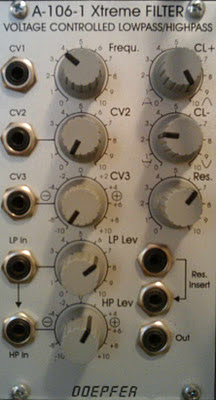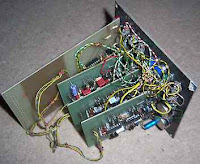The Doepfer A-106-1 Xtreme Filter was built as a kind of Korg MS20 filter clone.
The famous original MS20 included two filters: a 12 dB lowpass and a 6dB high pass filter connected in series both with a very special design.
On the A-106 product page Doepfer writes: " The A-106-1 is definitely not the right choice for "moogish" and "civilized" sounds but for extreme, exceptional and experimental sounds - this is why we call the module "X-Filter"... "
The famous original MS20 included two filters: a 12 dB lowpass and a 6dB high pass filter connected in series both with a very special design.
On the A-106 product page Doepfer writes: " The A-106-1 is definitely not the right choice for "moogish" and "civilized" sounds but for extreme, exceptional and experimental sounds - this is why we call the module "X-Filter"... "
Doepfer found a way to use the same circuit simultaneously as lowpass and highpass for 2 different audio signals (a bit similar to the A-101-1 Steiner Vactrol filter that has even different audio inputs available, but with the special MS20 circuit).
For this two separate audio inputs for lowpass(LP) and highpass (HP) with separate level controls are available.
The sockets are normalled, so the signal applied to the LP input is available for the HP input too provided that no plug is inserted into the HP input socket.
The level control of the HP input is realized as a polarized input. This means that the signal can be added with the same polarity (+ range) or opposite polarity (- range) compared to the LP input.
This feature enables notch (+) and bandpass (-) filter functions too.
A lot of audio-examples can be found HERE
and on Andreas Krebs' blog
As you will hear in the demo's this is a very nice sounding filter with a distinctive sound.
It can sound very squelchy and dirty, and still also quite smooth...
If you are looking for a do-it-all filter, this might be the one you are looking for.
It is not my favorite filter, but i still rate it at 7/10...
Video:
Hans Richter - Rhythmus 23 - Figur 10 - KABELTON
http://www.youtube.com/watch?v=vNW6XXvJ74A
" ...just a test for something bigger... but i like it though.the sound was made with benjolin (rob hordijk and joker nies) and doepfer a-106-1."
Uploaded by Kabelton









